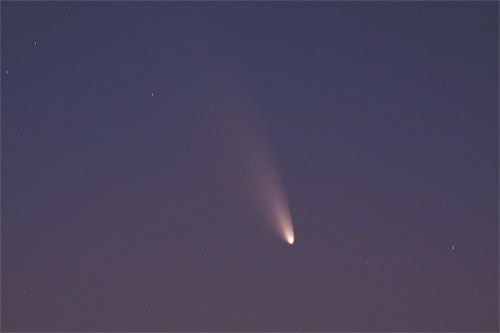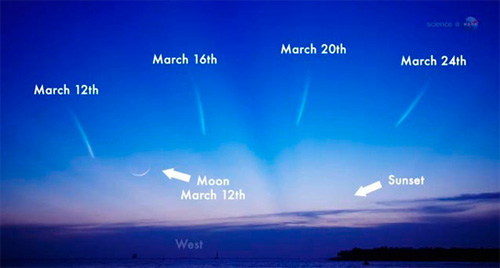
Comet PANSTARRS Rises to the Occasion Mid-March
March 09, 2013
"You might have heard of a comet ISON, which may become a spectacular naked-eye comet later this fall," said Amy Mainzer, the principal investigator of NASA's NEOWISE mission at the Jet Propulsion Laboratory in Pasadena, Calif., and self-described cosmic icy dirtball fan. "But if you have the right conditions you don't have to wait for ISON. Within a few days, comet PANSTARRS will be making its appearance in the skies of the Northern Hemisphere just after twilight."
Close-up of comet C/2011 L4 PANSTARRS
Since its discovery a year-and-a-half ago, observing comet PANSTARRS has been the exclusive dominion of comet aficionados in the Southern Hemisphere, but that is about to change. As the comet continues its well-understood and safe passage through the inner-solar system, its celestial splendor will be lost to those in the Southern Hemisphere, but found by those up north. "There is a catch to viewing comet PANSTARRS," said Mainzer. "This one is not that bright and is going to be low on the western horizon, so you'll need a relatively unobstructed view to the southwest at twilight and, of course, some good comet-watching weather." Well, there is one more issue -- the time of day, or night, to view it. "Look too early and the sky will be too bright," said Rachel Stevenson, a NASA Postdoctoral Fellow at JPL. "Look too late, the comet will be too low and obstructed by the horizon. This comet has a relatively small window."
For those in search of comet L4 PANSTARRS, look to the west after sunset in early and mid-March. This graphic shows the comet's expected positions in the sky.
The comet could be visible in the Northern Hemisphere evening sky low in the west after sunset. It will move northward each evening during March 2013 as it moves from being in front of the constellation Pisces to being in front of the constellations Pegasus and Andromeda. At this time, the comet might have a bright dust tail, and perhaps visible to the unaided eye or binoculars. It should, at least, if it lives up to expectations. Look for the comet in the vicinity of the waxing crescent moon on March 12, 13 and 14. What, if any, attraction does seeing a relatively dim naked-eye comet with the naked eye hold for someone who works with them every day, with file after file of high-resolution imagery spilling out on her computer workstation? "You bet I'm going to go look at it!" said Mainzer. "Comet PANSTARRS may be a little bit of a challenge to find without a pair of binoculars, but there is something intimately satisfying to see it with your own two eyes. If you have a good viewing spot and good weather, it will be like the Sword of Gryffindor, it should present itself to anyone who is worthy." NASA detects, tracks and characterizes asteroids and comets passing relatively close to Earth using both ground- and space-based telescopes. The Near-Earth Object Observations Program, commonly called "Spaceguard," discovers these objects, characterizes a subset of them, and predicts their paths to determine if any could be potentially hazardous to our planet. JPL manages the Near-Earth Object Program Office for NASA's Science Mission Directorate in Washington, DC. JPL is a division of the California Institute of Technology in Pasadena.
Source of News:
E-mail your news &
photos to editor@sitnews.us
|
||

